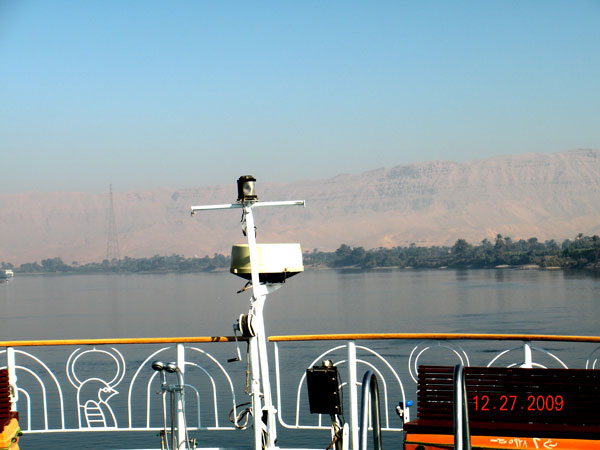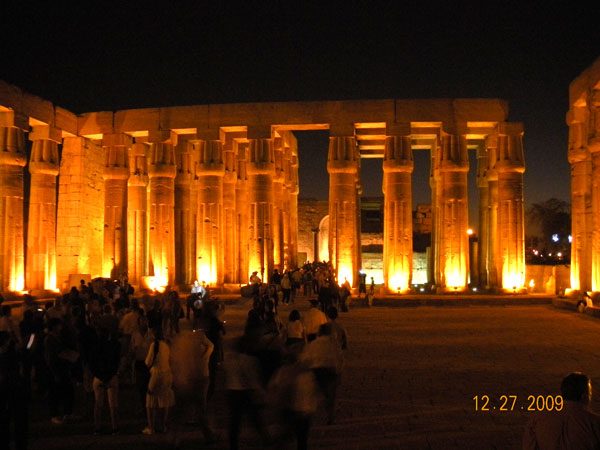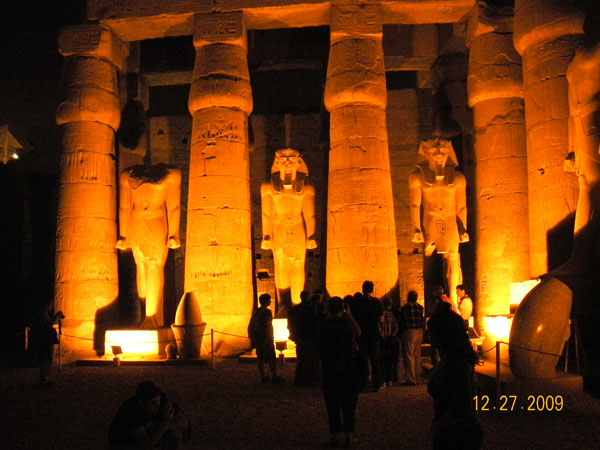Sunday, 27 December 2009
Shortly before we turned the lights out last night, the Ra II slipped its moorings at Kom Ombo and resumed its stately journey down the Nile toward Esne. We sailed along until about 3 AM when I was awakened by the sound of the gangplank being ratcheted down. I peered out between the curtains but was unable to see anything in the dark. We had stopped moving and at that hour there was nothing to do but go back to sleep.
In the morning, we emerged from our stateroom to find ourselves moored to the riverbank with no proper jetty in sight. One long green corrugated hose snaked down the bank and was connected to a fitting in the hull, either carrying something onto the ship or removing something from it. At breakfast, we learned that we had arrived at a lock on the river at Esne and that ships were awaiting their turn to traverse the lock. Shortly after breakfast, the gangplank was retrieved and we set off down the river again. About an hour later, we approached the lock system and slowed to a crawl. Entering the lock was a tricky business since there was very little leeway on either side of ship. We even bumped one side of the lock as the captain maneuvered us into place; a few feet only separated us from the closed gate at the stern and a second ship in front of us.


Once the gates of the lock closed, we were lowered about twenty feet to the river level below the dam. The entire process took less than an hour and we were soon traveling at speed again. The Nile slid past and we spent most of the morning sitting under an awning on the sun deck, reading and watching the subtle shifts in the landscape as we traveled. We encountered few boats moving in up river, but there were occasional commercial and pleasure craft.
 One such was a “dahabiyah,” all white, being towed by a small, similarly painted tugboat. This was the sort of conveyance that our friend Flo Nightingale would have made her trip in—minus the tugboat. I wondered how much different an experience that must have been. It looked to be a comfortable enough boat, but she reports that in addition to her three traveling companions, there were numerous crew members responsible for sailing or rowing or towing the boat along. It must have been quite cozy and her less than affectionate references to the companionship of various rodent and insect life forms made me appreciative of the comforts of our ship.
One such was a “dahabiyah,” all white, being towed by a small, similarly painted tugboat. This was the sort of conveyance that our friend Flo Nightingale would have made her trip in—minus the tugboat. I wondered how much different an experience that must have been. It looked to be a comfortable enough boat, but she reports that in addition to her three traveling companions, there were numerous crew members responsible for sailing or rowing or towing the boat along. It must have been quite cozy and her less than affectionate references to the companionship of various rodent and insect life forms made me appreciative of the comforts of our ship.

 Around noon, the landscape underwent a dramatic change; through the haze—which was surprising as much for its presence as for its heaviness—we saw a range of reddish mountains looming on the east bank. Here the Nile made a grand sweep to the west as it sought a way around this impediment to its progress. At times the mountains seemed close enough to touch, appearing right behind the narrow strip of green that bordered the river. Soon the mountains receded, however and we continued our float, taking in the landscape and relaxing. We spent a great deal of the morning topside alternately reading and taking in the view of the landscape. Everyday activities were being carried out in the small settlements we passed along the way. I had the sense that what we viewed as a bucolic environment had quite a different meaning for those who were scratching out a living and dependent on the river for their existence in a manner totally different from the cruise boat operators. Draft animals were everywhere; women did their laundry at the river’s edge, as countless generations of women before them had no doubt done. Children in hand-me-down galabiyahs herded animals or ran through the fields, some waving as we passed; others, apparently long since inured to sight of wealthy foreigners staring at them, went about their business without so much as a glance our way.
Around noon, the landscape underwent a dramatic change; through the haze—which was surprising as much for its presence as for its heaviness—we saw a range of reddish mountains looming on the east bank. Here the Nile made a grand sweep to the west as it sought a way around this impediment to its progress. At times the mountains seemed close enough to touch, appearing right behind the narrow strip of green that bordered the river. Soon the mountains receded, however and we continued our float, taking in the landscape and relaxing. We spent a great deal of the morning topside alternately reading and taking in the view of the landscape. Everyday activities were being carried out in the small settlements we passed along the way. I had the sense that what we viewed as a bucolic environment had quite a different meaning for those who were scratching out a living and dependent on the river for their existence in a manner totally different from the cruise boat operators. Draft animals were everywhere; women did their laundry at the river’s edge, as countless generations of women before them had no doubt done. Children in hand-me-down galabiyahs herded animals or ran through the fields, some waving as we passed; others, apparently long since inured to sight of wealthy foreigners staring at them, went about their business without so much as a glance our way.
Nile River Cruise Christmas 2009 from Karl Schaefer on Vimeo.
 In late afternoon, Luxor hove into view and we tied up at the Eastmar dock, some distance south of the city proper. After the ship was secured, we all trooped aboard a bus and set off for the famous Temple of Karnak. This temple stood and was active for over a thousand years. It is the largest pharaonic temple complex in Egypt. Numerous Pharaohs and their Greek and Roman successors renovated, rebuilt and expanded its precincts over time so that one sees a number of different architectural styles. The most spectacular element is the colonnaded hall of the main temple. The massive pillars are carved to resemble lotus plants, the capitals curving out gracefully at the top. The entire complex covers at least ten acres and includes a “sacred lake” where priests would ritually cleanse themselves before entering the inner sanctum. There’s an obelisk, too, one of two that originally stood here, their pyramidal tops sheathed in a mixture of gold and silver that brilliantly reflected the sun’s rays in honor of the sun god worshipped in this place. One of the obelisks was toppled and the second walled up out of spite and ironically preserved for us because of one ruler’s jealousy of a predecessor. Funny, how history works…
In late afternoon, Luxor hove into view and we tied up at the Eastmar dock, some distance south of the city proper. After the ship was secured, we all trooped aboard a bus and set off for the famous Temple of Karnak. This temple stood and was active for over a thousand years. It is the largest pharaonic temple complex in Egypt. Numerous Pharaohs and their Greek and Roman successors renovated, rebuilt and expanded its precincts over time so that one sees a number of different architectural styles. The most spectacular element is the colonnaded hall of the main temple. The massive pillars are carved to resemble lotus plants, the capitals curving out gracefully at the top. The entire complex covers at least ten acres and includes a “sacred lake” where priests would ritually cleanse themselves before entering the inner sanctum. There’s an obelisk, too, one of two that originally stood here, their pyramidal tops sheathed in a mixture of gold and silver that brilliantly reflected the sun’s rays in honor of the sun god worshipped in this place. One of the obelisks was toppled and the second walled up out of spite and ironically preserved for us because of one ruler’s jealousy of a predecessor. Funny, how history works…


From Karnak, we took the bus to a small gallery where papyrus is made and used to create wall hangings. This feature of the guided tour biz is now obviously a given; each company, it seems, makes deals with local artisanal outfits to try and improve their business. There are so many “touts” on the streets of tourist venues selling cheap knockoffs and reproductions that people making the real thing must have trouble competing. Not only that, but the junk sold on the streets gives the genuine articles a bad reputation. In addition, when one visits factories or workshops to purchase perfume, papyrus, or other such things, the tour operators guarantee “no hard sells and no hassles,” a big advantage for tourists who are harangued every step of their way to and from historical sites. This doesn’t mean that you aren’t dogged while you’re in the shop; they just don’t push stuff in your face all the time.
Seeing papyrus made was very interesting and the person doing the demonstration was well informed and competent. Thin slices of the pulp are cut and then two layers of the slices are laid at right angles to one another. The resulting sheets are put in a press to remove all the water and then placed in the air to dry. It was interesting to learn that while the spongy center of the plant was used for making writing material, the tougher outside of the plant stalk was also used for making shoes and other items of wear that needed to be durable. Unfortunately, while we were told that the art work on the papyrus sheets was “original,” all of it was pseudo-ancient Egyptian featuring clichéd figures of gods and goddesses and faux cartouches. Most of it was way too gaudy for us and no amount of subtle pressure was going to persuade us to buy.
As we exited the papyrus shop, the sun was setting. Our final stop of the day was to be Luxor Temple, a building at the opposite end of town from Karnak, and linked to it by a two kilometer long avenue lined on either side with goat-headed sphinxes. Two thousand of them, they estimate, from one end of the processional way to the other. Only part of this avenue has been excavated so the number is approximate, I think.
Like the temple of Kom Ombo on the previous day, the Temple of Luxor was awash in artificial light by the time we arrived. A few other busloads of people were here as well, Navigating the uneven paving stones, climbing over thresholds and jostling other people while trying to appreciate the grandeur of the ruins was a challenge, but as with Kom Ombo, the presence of so many lent a festive air to the evening. One could almost imagine one’s self in the midst of ancient revelers celebrating the annual symbolic marriage between the god an goddess whose homes these temples were. Throughout our visit, we were watched over by four statues of our friend Ramesses II, he of the supersized ego.



A short bus ride brought us back to the Ra II, where we enjoyed a hearty dinner and a brief musical entertainment before tiptoeing off to bed. Tomorrow is our last day in Upper Egypt and we need our rest before tackling the last excursion.